Walter Olson
This morning the Supreme Court handed down unanimous decisions in six cases. Three are likely to pass with little notice (Labcorp v. Davis, class action certification without injury, dismissed as improvidently granted; CC Devas (Mauritius) v. Antrix, foreign sovereign immunity meets personal jurisdiction, Samuel Alito writing; Blom Bank Sal v. Honickman, protecting finality of judgments, Alito writing). The bigger news is that the Court decided three cases that could have been ideologically polarizing, and in each case, one of the Justices from the liberal wing wrote an opinion likely to please more conservative onlookers.
In Smith & Wesson Brands, campaigners seeking gun control through liability litigation had tried yet another way to get around the Protection of Lawful Commerce in Arms Act (PLCAA), in which Congress cut off such suits, by bringing in the government of Mexico as a plaintiff. The Justices weren’t having it, and Elena Kagan wrote for a 9–0 Court, with concurrences from Clarence Thomas and Ketanji Jackson. No Justice appeared to be looking for a way to evade and subvert PLCAA, a goal that is still popular in some activist and legal academic circles.
In Catholic Charities Bureau v. Wisconsin Labor and Industry Review Commission, the state of Wisconsin had interpreted the religious-organization exemption to its unemployment compensation program to exclude Catholic Charities on the grounds that its programs weren’t religious enough; they didn’t proselytize and were happy to serve non-Catholics. That approach played favorites between religious charities based on theological principles of how to do good works and flunked strict scrutiny, the Court ruled 9–0 per Sotomayor, with Thomas and Jackson concurrences. It could prove an important legal reinforcement for the independence of church institutions.
In Ames v. Ohio Department of Youth Services, the unanimous Court ruled that “reverse” discrimination suits don’t need to clear an additional threshold of background circumstances. As I put it in a statement for Cato:
Federal civil rights law generally entitles employees who say they were victims of so-called reverse discrimination—that is, based on their membership in a majority or otherwise dominant demographic group covered by the law—to the same right to sue as minority employees. Some federal courts nonetheless have required them to meet an additional and heightened standard of evidence, based on the idea that that kind of discrimination is exceptional and should require extra proof. Not so. It’s heartening to see a unanimous Supreme Court, with Justice Ketanji Brown Jackson writing, make clear that the law here is plain, and equality means everybody.
Every few years I write about how for all the genuine ideological conflict that plays out at the Court, most of its business is done on a more collegial, craftsmanlike, and consensus-seeking level. Here’s what I wrote in 2014 after the Court surprised some observers by handing down two unanimous decisions on business cases, one nominally “pro-business” and the other the opposite.























